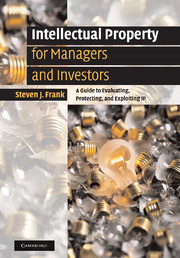 Intellectual Property for Managers and Investors
Intellectual Property for Managers and Investors 1 - Sketching the IP landscape
Published online by Cambridge University Press: 06 August 2009
Summary
IP? What's IP?
What's in your head is intellect – the mind, emotions, imagination and creativity, problem-solving ability. “Intellectual property” (IP) establishes rights in intellect made real – writing, art, music, invention. IP rights are bastions of ownership created by law and granted automatically or by government agency or decree. Though intangible, IP is no less real than a bank account or citizenship. But IP rights are creatures of the laws that underpin them. Only those expressions of intellect falling within a favored category receive protection, allowing the owner to prevent unauthorized use. Everything else is unprotectible; it belongs to the public.
Most creative efforts will be eligible for protection within some IP regime. The traditional categories, and the ones with which we will be most concerned, are:
patents: protect most technologies – useful articles and machines, processes, and compositions of matter, as well as ornamental designs and plants;
trademarks: protect words, names, symbols, sounds, or colors that distinguish goods and services;
copyrights: protect works of authorship, such as writings, music, and artworks that have been tangibly expressed, as well as computer software;
trade secrets: information, such as formulas and manufacturing techniques, that companies keep secret to give them an advantage over their competitors.
It is important to distinguish IP from obligations created by contract, custom, or other law; for example, anything an employee creates in the course of his work may belong to his employer.
- Type
- Chapter
- Information
- Intellectual Property for Managers and InvestorsA Guide to Evaluating, Protecting and Exploiting IP, pp. 1 - 24Publisher: Cambridge University PressPrint publication year: 2006
